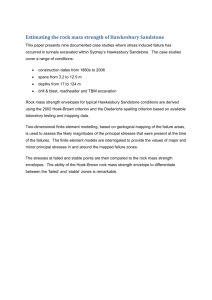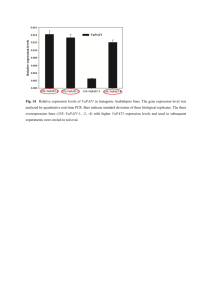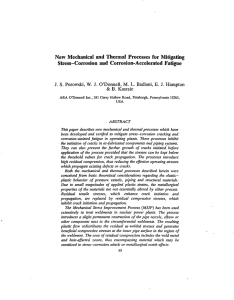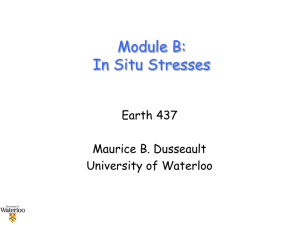Mechanics of Natural Fractures II
advertisement
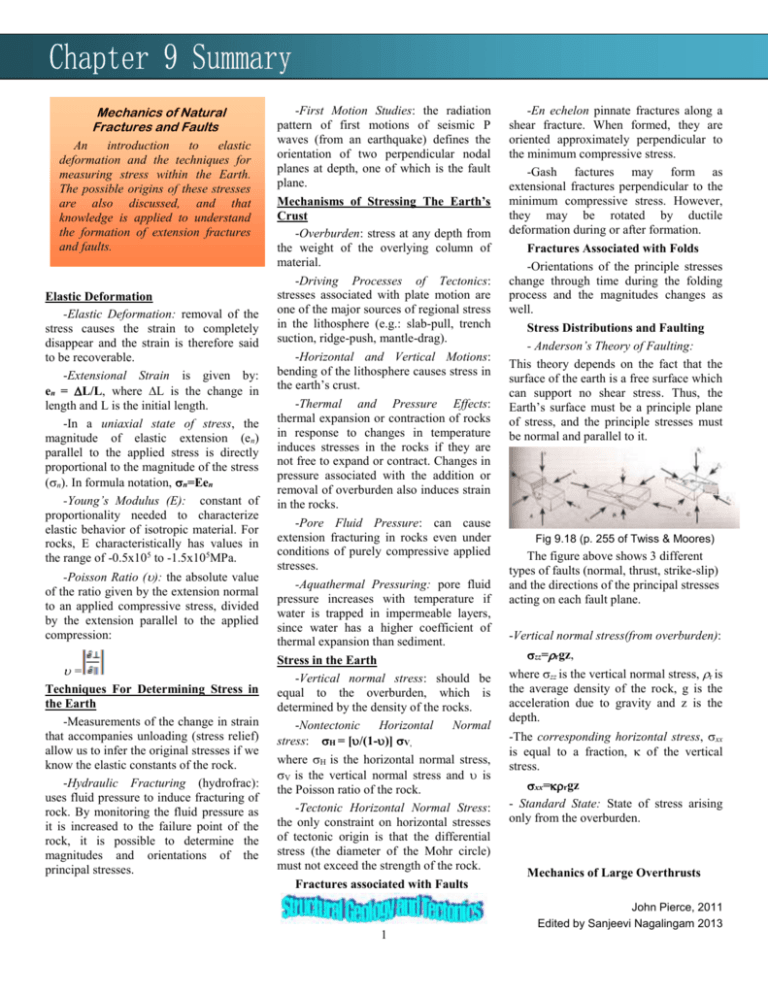
Mechanics of Natural Fractures and Faults An introduction to elastic deformation and the techniques for measuring stress within the Earth. The possible origins of these stresses are also discussed, and that knowledge is applied to understand the formation of extension fractures and faults. Elastic Deformation -Elastic Deformation: removal of the stress causes the strain to completely disappear and the strain is therefore said to be recoverable. -Extensional Strain is given by: en = L/L, where L is the change in length and L is the initial length. -In a uniaxial state of stress, the magnitude of elastic extension (en) parallel to the applied stress is directly proportional to the magnitude of the stress (n). In formula notation, n=Een -Young’s Modulus (E): constant of proportionality needed to characterize elastic behavior of isotropic material. For rocks, E characteristically has values in the range of -0.5x105 to -1.5x105MPa. -Poisson Ratio (): the absolute value of the ratio given by the extension normal to an applied compressive stress, divided by the extension parallel to the applied compression: = Techniques For Determining Stress in the Earth -Measurements of the change in strain that accompanies unloading (stress relief) allow us to infer the original stresses if we know the elastic constants of the rock. -Hydraulic Fracturing (hydrofrac): uses fluid pressure to induce fracturing of rock. By monitoring the fluid pressure as it is increased to the failure point of the rock, it is possible to determine the magnitudes and orientations of the principal stresses. -First Motion Studies: the radiation pattern of first motions of seismic P waves (from an earthquake) defines the orientation of two perpendicular nodal planes at depth, one of which is the fault plane. Mechanisms of Stressing The Earth’s Crust -Overburden: stress at any depth from the weight of the overlying column of material. -Driving Processes of Tectonics: stresses associated with plate motion are one of the major sources of regional stress in the lithosphere (e.g.: slab-pull, trench suction, ridge-push, mantle-drag). -Horizontal and Vertical Motions: bending of the lithosphere causes stress in the earth’s crust. -Thermal and Pressure Effects: thermal expansion or contraction of rocks in response to changes in temperature induces stresses in the rocks if they are not free to expand or contract. Changes in pressure associated with the addition or removal of overburden also induces strain in the rocks. -Pore Fluid Pressure: can cause extension fracturing in rocks even under conditions of purely compressive applied stresses. -Aquathermal Pressuring: pore fluid pressure increases with temperature if water is trapped in impermeable layers, since water has a higher coefficient of thermal expansion than sediment. Stress in the Earth -Vertical normal stress: should be equal to the overburden, which is determined by the density of the rocks. -Nontectonic Horizontal Normal stress: H = [/(1-)] V, where H is the horizontal normal stress, V is the vertical normal stress and is the Poisson ratio of the rock. -Tectonic Horizontal Normal Stress: the only constraint on horizontal stresses of tectonic origin is that the differential stress (the diameter of the Mohr circle) must not exceed the strength of the rock. Fractures associated with Faults 1 -En echelon pinnate fractures along a shear fracture. When formed, they are oriented approximately perpendicular to the minimum compressive stress. -Gash factures may form as extensional fractures perpendicular to the minimum compressive stress. However, they may be rotated by ductile deformation during or after formation. Fractures Associated with Folds -Orientations of the principle stresses change through time during the folding process and the magnitudes changes as well. Stress Distributions and Faulting - Anderson’s Theory of Faulting: This theory depends on the fact that the surface of the earth is a free surface which can support no shear stress. Thus, the Earth’s surface must be a principle plane of stress, and the principle stresses must be normal and parallel to it. Fig 9.18 (p. 255 of Twiss & Moores) The figure above shows 3 different types of faults (normal, thrust, strike-slip) and the directions of the principal stresses acting on each fault plane. -Vertical normal stress(from overburden): zz=rgz, where zz is the vertical normal stress, r is the average density of the rock, g is the acceleration due to gravity and z is the depth. -The corresponding horizontal stress, xx is equal to a fraction, of the vertical stress. xx=rgz - Standard State: State of stress arising only from the overburden. Mechanics of Large Overthrusts John Pierce, 2011 Edited by Sanjeevi Nagalingam 2013 -The driving force required to move a block must be greater than or equal to the frictional resistance. -High pore fluid pressure along a decollement would reduce the frictional resistance. The greater the friction, the smaller the block is allowed to be. -Commonly follow layers of weak rock in the stratagraphic section. - Gravity as a driving force would act on every individual point on the block. - A slope of at least 31 is required for a block to be moved gravitationally. Critical Coulomb Wedge model: -Describes the mechanisms of a brittle, deformable thrust sheet undergoing frictional sliding on a basal decollement. - We assume that the rocks in the thrust sheet are everywhere just at the critical stress for failure as defined by the coulomb fracture criterion. - Dip of the decollement affects the resistance to motion of the thrust sheet in three ways 1) Steeper dip means move driving force needed. 2) Higher slope increases the normal stress on the decollement. 3) Increase in the slope increases the area of the vertical face at any given distance from the toe. References & Resources 1. Robert J. Twiss, Eldridge M. Moores, Structural Geology 2nd edition, (W. H. Freeman), p. 231268, 2006. 2. Anderson's Theory of Faulting. Web URL: http://www.geology.cwu.edu/facs taff/charlier/courses/g360/anderso n.html 3. Faults and Stresses. Web URL: http://homepage.usask.ca/~mjr34 7/prog/geoe118/geoe118.051.html John Pierce, 2011 Edited by Sanjeevi Nagalingam 2013 2

